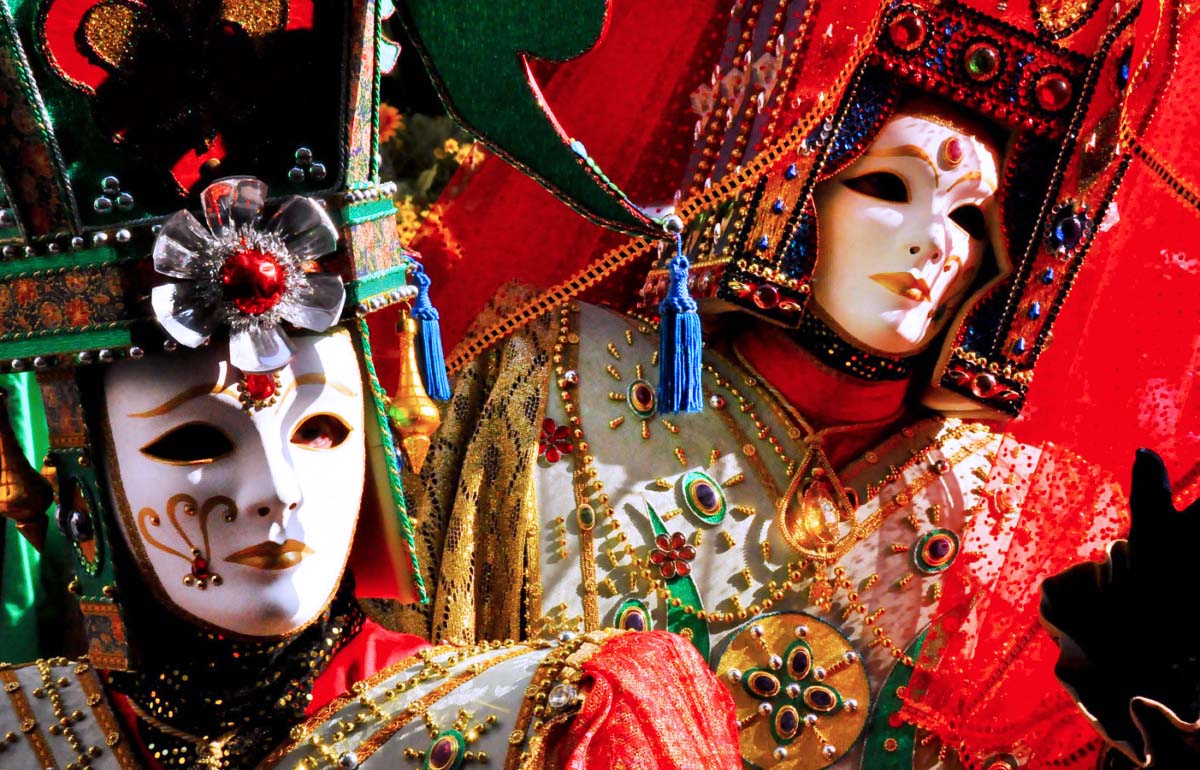The history of the Venetian mask dates back to the 13th century when Venice was just a small city in the extreme northeastern part of the Italian Peninsula. Venice at that time was a very important city among a conglomerate of small Italian city-states, known by the name of the Venetian Republic. Although the population was not large, the Republic was a major ship building center and was able to produce a battleship in as little as thirty days.
Other trades developed and the citizens of Venice became wealthy and successful. This wealth, luxury and extravagance, coupled with the beauty of the state, made the Republic very appealing to the rest of the world and led to the creation of the mask making trade.
Unlike the vast majority of their counterparts in contemporary Europe, most citizens in Venice enjoyed a high standard of living. Venice was capitalizing on its position long before its contemporaries had realized the value of a market economy. With a level of social wealth unequaled since, the citizens of Venice developed a unique culture, one in which the concealing of the identity in daily life became paramount to daily activity.
Additionally, the masks served an important social purpose of keeping every citizen on an equal playing field. Masked, a servant could be mistaken for a nobleman or vice versa. State inquisitors and spies could question citizens without fear of their true identity being discovered and citizens could answer without fear of retribution. The morale of the people was maintained through the use of masks, for with no faces, everyone had voices.
The masks they wore became so popular that the mascherari or mask-makers, were well-established as a trade by 1436. They were assisted in crafting their masks by sign-painters who drew faces onto papier-mâché in a range of different shapes with extreme attention to detail. The practice of wearing masks for disguise reached its zenith in the 18th century, when Venetians of different social classes used Carnevale as an excuse to behave in ways they normally could not, without fear of retribution.
The wearing of masks in daily life was eventually banned and limited only to certain months of the year and the masquerade went through periods of being outlawed by the Catholic Church, especially during Holy Days. The policy eventually led permitting Venetians to don masks from Santo Stefano’s feast day (December 26) up until Lent and also during official events of the Serenissima Republic. Since Shrove Tuesday was the last day to wear masks, the period leading up to Lent evolved into Carnevale, meaning “remove meat.” Although Venetian Carnevale lost popularity as Venice’s cultural production faltered during the Enlightenment, it was officially reintroduced in 1979.
Venetian masks are characterized by their ornate design, featuring bright colors such as gold or silver and the use of complex decorations in the Baroque style. Many of today’s mask designs stem from the Commedia dell’arte. They can be full face masks or simple eye masks.
Bauta, one the most common mask covers the whole face with a stubborn chin line, no mouth and lots of gilding. The masks that only cover the area around the eyes are referred to as Columbina. The Moretta is an oval mask of black velvet that was usually worn by women visiting convents. It gained rapid popularity in Venice as it brought out the beauty of feminine features. The mask was finished off with a veil and was secured in place by a small bit in the wearer’s mouth. The Volto (face) was the more common mask used in Venice for centuries allowing the wearer to breathe, eat and speak easily without removing the masks. The Medico Della Peste mask, with its long beak, is one of the most bizarre creations and was thought to have protected the wearer from infection during the Black Plague. The long nose was filled with potpourri.
As times change, so do traditions. Today, Venetian masks are typically worn during the Carnival of Venice celebration and in the Commedia dell’Arte Theater productions. The modern celebration of Venetian Carnevale has reinvigorated the art and craft of making Venetian masks, which remain popular not only during Carnevale celebrations, but are extremely popular with tourists. Commercially produced and hand-crafted masks are available for sale in Venice year-round and also online and in stores worldwide. Wearing Venetian masks has spread to Halloween masquerade balls and Mardi Gras in North and South America. Regardless of the name, Carnevale always carries with it rich Italian history.
Although Carnevale is celebrated throughout Italy, Venice’s version that began so many centuries ago is now one of the most famous festivals in the world. With giant crowds of people, amazing music, ostentatious garb and delicious food, Carnevale is definitely a sensory overload.





